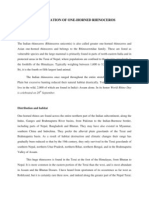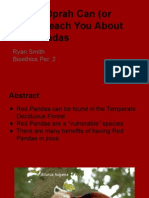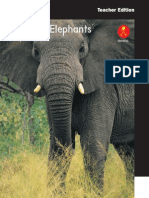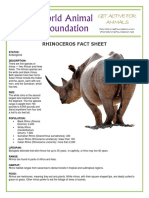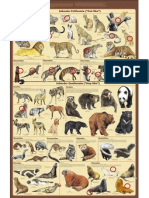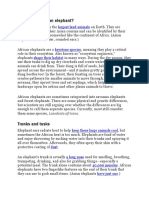Elephants: Facts
Elephants: Facts
Uploaded by
Angelo HuligangaCopyright:
Available Formats
Elephants: Facts
Elephants: Facts
Uploaded by
Angelo HuligangaOriginal Title
Copyright
Available Formats
Share this document
Did you find this document useful?
Is this content inappropriate?
Copyright:
Available Formats
Elephants: Facts
Elephants: Facts
Uploaded by
Angelo HuligangaCopyright:
Available Formats
ELEPHANTS
FACTS
• Elephants are the world’s largest land animals and one of our
most iconic species.
• In Africa, the elephant population has declined from 5-10
million in 1930 to around 500,000 today. Over 20,000
elephants are poached every year. Equally troubling, Asian
elephants have seen their numbers decline from 200,000 to
roughly 40,000 over the course of the last century.97 Only
2500 Sumatran elephants are left on earth. This map shows
the distribution of African elephants, while this map pinpoints
the locations of Asian elephants.
• Why do people say that elephants never forget? Elephant brains weigh almost 5 kilograms, the
largest of any land animal, which gives them extraordinary memory storage and recall.
• Elephants are one of the few animals on earth that can recognize themselves in a mirror—which
means that they have a sense of self, distinct from others!
• Elephants have saved humans from drowning!
• Elephants are capable of complex thoughts and deep feelings, including love, anger, and sadness.98
For instance, when two elephants are reunited, it is a highly emotional occasion. The greeting
ceremony begins with exuberance and drama, concluding with expressions of what humans would
describe as utter joy.99
• Elephants’ sight is relatively poor, so they rely on smell and sound to guide their decisions, which
explains their long and sensitive trunks.
WHY THEY MATTER
Economic Contribution: From books to films to poetry, elephants
have inspired all of us for centuries. In very practical terms, Protect Our Species Primer and Action Toolkit
elephants are “tourism magnets,” attracting funding that helps
protect wilderness areas. Each African elephant generates at least
$1.5 million annually100 in eco-tourism for the local economy—crit-
ically needed resources for African communities. By one estimate,
elephant poaching reduces African tourism by $25 million a year.101
Role in the Ecosystem: Elephants are a keystone species, playing
an important role in maintaining the biodiversity of the ecosys-
tems in which they live. They flatten dense grasslands, creating
habitat for smaller species. African elephants also dig water holes,
which are used by other species. Elephants travel long distances
in search for food, dispersing seeds contained in their waste along
51
®
EARTH DAY NETWORK
the way, helping to generate new green growth.102 In some areas,
species of plants and trees rely entirely upon elephants for seed
dispersal for their survival.
THREATS
Poaching: The most severe threat facing African elephants is
poaching and the now illegal global ivory trade. More than 100
elephants are killed every day for their tusks. In recent years,
poaching of elephants has increased exponentially, even in the
face of global outrage and treaties, leading to dramatic reductions
in this already vulnerable species.103 Asian elephants are being
targeted by poachers for their skin which is used for commercial
and medicinal purposes.104
Habitat Loss: Habitat loss fuels a vicious cycle in the elephant ecosystem. Rising and expanding
human populations reduce the habitat available to elephants, putting them in closer proximity to
humans, leading to more elephant killings.105
Climate Change: Elephants are already feeling the impacts of global warming. Droughts lead to food
shortages and reduced habitat. Droughts also disrupt the mating season, which leads to fewer offspring.106
HOW TO HELP
Join the Movement to Stop the Ivory Trade: Illegal or legally sourced, the ivory trade is decimating
our remaining elephants. China, once the world’s largest importer of ivory, and long considered the
country most responsible for the decimation of elephants, recently joined the United States, declaring
a near total ban on ivory sales. Nonetheless illegal trade continues throughout the world. Many coun-
tries ban trade altogether but some, such as Great Britain, allow trade in antique or “certified” ivory,
but those limitations are often ignored.
Speak Up Against Trophy Hunting. The National Rifle Association and the Safari Club, both big-game
trophy hunting groups, successfully petitioned the Trump Administration to reverse the Obama-era
rules that banned imports of elephant tusks and other animal parts. Although our courts stepped
in, Trump’s officials are still “studying the issue.” Let’s keep the pressure on. Write to Donald Trump
and the U.S. Fish and Wildlife Service and tell them to keep the ban! And tell the National Rifle
Association and the Safari Club to back off.
Protest Elephant Exhibitions: Elephants are used for a variety of human entertainment – from the
circus to elephant-back rides – which contributes to their endangerment. It is important to speak out
against these cruel practices.107 Protect Our Species Primer and Action Toolkit
Practice Sustainable Tourism: Only travel with companies that are certified as sustainable. If you are
fortunate enough to see an animal in the wild, make sure that your interaction is respectful.
52
®
EARTH DAY NETWORK
ADDITIONAL RESOURCES
ARTICLES/BLOGS/READINGS
Basic Facts About Elephants – Defenders of Wildlife
https://defenders.org/elephant/basic-facts
This article gives basic background information about elephants including their diet, range, popula-
tion size, and behavior among other info.
End Illegal Wildlife Trade – Defenders of Wildlife
https://defenders.org/end-illegal-wildlife-trade
This article gives a brief description of the issues with the illegal wildlife trade and ways to combat it.
Who Will Save the Elephants? Inside the race to make sure that the planet’s largest land mammal
doesn’t just disappear – Vogue
https://www.vogue.com/projects/13544708/save-the-elephants-elephant-crisis-fund/
This is an article on elephant trophy hunting and conservation efforts.
Human - Elephant Conflict – World Wildlife Federation
http://wwf.panda.org/knowledge_hub/endangered_species/elephants/human_elephant_conflict.cfm
This article highlights the issues elephants face as their habitat continues to shrink as well as showing
the consequences of people living in the same area as elephants.
VIDEOS
Elephants 101 – National Geographic
https://www.youtube.com/watch?v=Aw6GkiCvcWs
This video presents an overview of both Asian and African elephants - their habitat, way of life, and,
unfortunately, their most pressing threats to their survival.
TED-Ed: Why Elephants Never Forget – Alex Gendler
https://www.youtube.com/watch?v=lSXNqsOoURg
It’s a common saying that elephants never forget. But the more we learn about elephants, the more
it appears that their impressive memory is only one aspect of an incredible intelligence that makes
them some of the most social, creative, and benevolent creatures on Earth. Protect Our Species Primer and Action Toolkit
STORYTELLING
Elephant: King Of The Kalahari – National Geographic
https://www.youtube.com/watch?v=YL_S4UjgdJ4
Botswana is home to more African elephants than anywhere else in the world. Every year, thousands
of elephants trek over 7,000 miles in search of food and life-giving water. The desert is a hostile place,
especially as the dry season takes hold, so the elephants must use their strength and wit to survive.
53
®
EARTH DAY NETWORK
OTHERS WORKING ON THIS
Save the Elephants
https://www.savetheelephants.org/
Save the Elephants is an organization that both monitors the location of elephant species for conser-
vationists and researchers as well as works with wildlife agencies to protect elephants from poaching.
Elephant Aid International
https://elephantaidinternational.org/
Elephant Aid International works to promote greater educational awareness of elephants and pro-
vides hands-on assistance to local caretakers of both wild and captive elephants.
International Elephant Foundation
https://elephantconservation.org/
The International Elephant Foundation strives to create a sustainable future for elephants by support-
ing elephant conservation, education, research, and management programs worldwide.
REPORTS
Status of African elephant populations and levels of illegal killing and the illegal trade in ivory –
IUCN
https://cmsdata.iucn.org/downloads/african_elephant_summit_background_document_2013_en.pdf
The results of this report show that levels of poaching and the illegal ivory trade started to increase
again in the mid-2000s, following an easing in the 1990s, the rate of increase jumping dramatically
from 2009. The overall trend appears to be leveling off in 2012 compared to 2011, but still at an unsus-
tainably high level.
Elephants are the latest conflict resource – United Nations
https://www.traffic.org/site/assets/files/4180/elephants_in_the_dust.pdf
The African elephant, the largest remaining land mammal on the planet, is facing the greatest crisis
in decades. Reports of mass elephant killings in the media vividly illustrate the situation across many
African elephant ranges. This Rapid Response Assessment provides an overview of the current state
of the African elephant alongside recommendations for action to ensure its protection.
Protect Our Species Primer and Action Toolkit
54
®
EARTH DAY NETWORK
You might also like
- Diversity WheelDocument8 pagesDiversity WheelNathaniel AzulNo ratings yet
- The Big Brown BearDocument4 pagesThe Big Brown BearRoxana MunteanuNo ratings yet
- Panda FactsDocument6 pagesPanda FactsTobi GambleNo ratings yet
- Tigers: Revered Around The World, But Persecuted Throughout Its RangeDocument4 pagesTigers: Revered Around The World, But Persecuted Throughout Its RangedharshanaNo ratings yet
- WP Integrating Active Directory MLDocument14 pagesWP Integrating Active Directory MLFarid BouNo ratings yet
- Sample Operative Report For 2014Document30 pagesSample Operative Report For 2014Hemant KumarNo ratings yet
- 200 KWDocument1,013 pages200 KWSalih Hassan SalihNo ratings yet
- The Architectural Precedent and The Diagram A Comparative Analysis of Le Corbusier's Villa Savoye and Rem Koolhaas' Maison A Bordeaux PDFDocument118 pagesThe Architectural Precedent and The Diagram A Comparative Analysis of Le Corbusier's Villa Savoye and Rem Koolhaas' Maison A Bordeaux PDFNancy Al-Assaf50% (2)
- Elephants - The Facts: Iamnot A Trinket. Say No To Elephant IvoryDocument2 pagesElephants - The Facts: Iamnot A Trinket. Say No To Elephant IvoryFraserBulbucNo ratings yet
- The African Forest ElephantDocument6 pagesThe African Forest ElephantJames Remington Orozco NewtonNo ratings yet
- My First Book about Rhinoceroses: Amazing Animal Books - Children's Picture BooksFrom EverandMy First Book about Rhinoceroses: Amazing Animal Books - Children's Picture BooksNo ratings yet
- Black Bears: The North Shore Is Bear CountryDocument1 pageBlack Bears: The North Shore Is Bear Countryjanice3beesley3beckNo ratings yet
- The Indian Rhinoceros: by John-Luke Voshall Bio 227Document6 pagesThe Indian Rhinoceros: by John-Luke Voshall Bio 227JohnLukeVNo ratings yet
- 1 Horned RhinoDocument12 pages1 Horned RhinoPrachi NikhadeNo ratings yet
- Eleph Ant Carrying Capacity of Odisha's Forests: Asian Nature Conserva On Founda OnDocument66 pagesEleph Ant Carrying Capacity of Odisha's Forests: Asian Nature Conserva On Founda OnGopal SvNo ratings yet
- Narrative TextDocument7 pagesNarrative TextNorma AyunitaNo ratings yet
- Giant Panda: 1 DescriptionDocument18 pagesGiant Panda: 1 DescriptionMsKarolyNo ratings yet
- Drinking Water Report 2021Document6 pagesDrinking Water Report 2021api-277511356No ratings yet
- RhinocerosDocument2 pagesRhinocerosDyah AyuNo ratings yet
- What Oprah Can (Or Can't) Teach You About Red Pandas: Ryan Smith Bioethics Per. 2Document16 pagesWhat Oprah Can (Or Can't) Teach You About Red Pandas: Ryan Smith Bioethics Per. 2Ryan Benson SmithNo ratings yet
- Red Panda Traits PageDocument1 pageRed Panda Traits Pageapi-262773079No ratings yet
- Green Organic Shape Animal Conservation PresentationDocument6 pagesGreen Organic Shape Animal Conservation Presentationyaya payaNo ratings yet
- Drinking WaterDocument11 pagesDrinking WaterVinodNo ratings yet
- The Giant PandaDocument3 pagesThe Giant PandaMamat AdoumaNo ratings yet
- African Bush ElephantDocument19 pagesAfrican Bush ElephantAlison_VicarNo ratings yet
- Grizzly BearDocument11 pagesGrizzly Bearapi-437469743No ratings yet
- TigerDocument6 pagesTigerAnonymous J70OQBprUSNo ratings yet
- Automati Pump ControllerDocument8 pagesAutomati Pump ControllermbadaNo ratings yet
- A Red Pandas Ecostem Written Peice by Brooke FischerDocument3 pagesA Red Pandas Ecostem Written Peice by Brooke Fischerapi-377080751No ratings yet
- EVSDocument28 pagesEVSH8000100% (1)
- Bears Are Carnivoran Mammals of The Family Ursidae. They Are Classified AsDocument29 pagesBears Are Carnivoran Mammals of The Family Ursidae. They Are Classified AsmcmusbixNo ratings yet
- Black Bear Fact Sheet (RI DEM)Document5 pagesBlack Bear Fact Sheet (RI DEM)Frank MaradiagaNo ratings yet
- The Great Big ElephantsDocument16 pagesThe Great Big ElephantsvenumeNo ratings yet
- BearDocument20 pagesBearMsKarolyNo ratings yet
- North America Range: ProcyonDocument4 pagesNorth America Range: ProcyonIT MalurNo ratings yet
- Tiger Is The Largest Carnivorous Mammal Animal of The Cat FamilyDocument5 pagesTiger Is The Largest Carnivorous Mammal Animal of The Cat FamilyLucasNo ratings yet
- Bengal Tiger Presentation 2Document20 pagesBengal Tiger Presentation 2Jauha HanafiNo ratings yet
- Save The TigerDocument5 pagesSave The TigerChiranjit Saha100% (1)
- The Red PandaDocument1 pageThe Red PandaBianca WolfNo ratings yet
- Significance of Wildlife ConservationDocument5 pagesSignificance of Wildlife ConservationSandeep GuptaNo ratings yet
- Red Panda Report For Ariel HyersDocument11 pagesRed Panda Report For Ariel HyersFelicia FerentinosNo ratings yet
- The Rhinoceros (Rhino)Document5 pagesThe Rhinoceros (Rhino)Bella ChiekytaNo ratings yet
- TV, Appliances, Electronics: Low LowDocument2 pagesTV, Appliances, Electronics: Low LowArto GraphicNo ratings yet
- Tiger ProjectDocument18 pagesTiger Projectpraveen181274No ratings yet
- What Are Total Dissolved Solids (TDS) Level in Drinking Water & How To ReduceDocument8 pagesWhat Are Total Dissolved Solids (TDS) Level in Drinking Water & How To ReduceHarishKumarNo ratings yet
- Writing Polar BearDocument4 pagesWriting Polar BearGaMesCaroLinaNo ratings yet
- Rare BearsDocument4 pagesRare BearsFilipe MendesNo ratings yet
- Polar Bear Report SBI3uDocument2 pagesPolar Bear Report SBI3uDillon MercerNo ratings yet
- TigerDocument27 pagesTigerMsKarolyNo ratings yet
- PandaDocument4 pagesPandaGabriel MaximNo ratings yet
- Drinking Water SolutionsDocument16 pagesDrinking Water SolutionsLiviu SomesanNo ratings yet
- Tiger: This Article Is About The Big Cat. For Other Uses, See - "Tigress" Redirects Here. For Other Uses, SeeDocument39 pagesTiger: This Article Is About The Big Cat. For Other Uses, See - "Tigress" Redirects Here. For Other Uses, SeeSharmistha Talukder Khastagir100% (1)
- RaccoonDocument22 pagesRaccoonjack100% (1)
- Endangered Species TigersDocument15 pagesEndangered Species TigersJohn NgooNo ratings yet
- Red Panda!!!!!!!!!Document16 pagesRed Panda!!!!!!!!!shipleylowerschoolNo ratings yet
- African Forest ElephantDocument13 pagesAfrican Forest ElephantAlison_VicarNo ratings yet
- POLAR BEARS-Biology ProjectDocument16 pagesPOLAR BEARS-Biology Projectserwaa21No ratings yet
- Pho Drinking Water Report 2019Document253 pagesPho Drinking Water Report 2019Adha FerroNo ratings yet
- Centrifugal Pump ExperimentsDocument18 pagesCentrifugal Pump ExperimentssamadonyNo ratings yet
- 80 Interesting Bear FactsDocument3 pages80 Interesting Bear FactsPriestess AravenaNo ratings yet
- Rhinoceros PDFDocument2 pagesRhinoceros PDFSatyabrat DuttaNo ratings yet
- Red Pandas Like To Nap-Wordscientists-FKB PDFDocument13 pagesRed Pandas Like To Nap-Wordscientists-FKB PDFMariana LunaNo ratings yet
- A253 Carnivora - 105 Low RezDocument1 pageA253 Carnivora - 105 Low RezMAnsi CHoukseyNo ratings yet
- Elephants Facts: 1. Use The Words From The Box and Label The Elephant Body Parts (Follow The Example)Document4 pagesElephants Facts: 1. Use The Words From The Box and Label The Elephant Body Parts (Follow The Example)Kevin Andrey Rios SolanoNo ratings yet
- What Is The African ElephantDocument6 pagesWhat Is The African ElephantNovaldi Luviano SangerNo ratings yet
- Novel Coronavirus (2019-Ncov) Nucleic Acid Diagnostic Kit (Pcr-Fluorescence Probing)Document27 pagesNovel Coronavirus (2019-Ncov) Nucleic Acid Diagnostic Kit (Pcr-Fluorescence Probing)Angelo HuligangaNo ratings yet
- Wings: Boneless: - TraditionalDocument2 pagesWings: Boneless: - TraditionalAngelo HuligangaNo ratings yet
- Budgeting Basics: A Companion Guide To Keeping It Real: How To Get The Support You Need For The Life You WantDocument20 pagesBudgeting Basics: A Companion Guide To Keeping It Real: How To Get The Support You Need For The Life You WantAngelo HuligangaNo ratings yet
- 1) Budgeting Basics - IntroductionDocument20 pages1) Budgeting Basics - IntroductionAngelo HuligangaNo ratings yet
- Accrual Budgeting and Fiscal Policy: Marc RobinsonDocument29 pagesAccrual Budgeting and Fiscal Policy: Marc RobinsonAngelo HuligangaNo ratings yet
- JOB ORDER PUBLICATION Final PDFDocument3 pagesJOB ORDER PUBLICATION Final PDFAngelo HuligangaNo ratings yet
- KanGuard NMCDDocument24 pagesKanGuard NMCDAngelo HuligangaNo ratings yet
- Thesis One Way AnovaDocument8 pagesThesis One Way Anovajessicastapletonscottsdale100% (2)
- Genagen CAB (Version 2013)Document2 pagesGenagen CAB (Version 2013)punyamputt2811100% (1)
- SEMIKRON DataSheet SKiiP 11AC126V1 25230030 PDFDocument4 pagesSEMIKRON DataSheet SKiiP 11AC126V1 25230030 PDFNanang Roni WibowoNo ratings yet
- Black Arabs in Macadomian ArtDocument10 pagesBlack Arabs in Macadomian ArtWesley MuhammadNo ratings yet
- Crop Yield Prediction Based On Indian Agriculture Using Machine LearningDocument5 pagesCrop Yield Prediction Based On Indian Agriculture Using Machine LearningDDNo ratings yet
- Husbands and Wives 202008Document2 pagesHusbands and Wives 202008amy bartlett100% (3)
- PD 1096 - Basic LawDocument1 pagePD 1096 - Basic Lawhannah marvillaNo ratings yet
- High AvailabilityDocument38 pagesHigh AvailabilityathulyabeenaraniNo ratings yet
- Build and Fly This Model of The: Cirrus SR22Document2 pagesBuild and Fly This Model of The: Cirrus SR22RX 6700 XTNo ratings yet
- Data Protection Requirements ChecklistDocument1 pageData Protection Requirements ChecklistsaifulazizNo ratings yet
- Prequalification List of Suppliers & Contractors FY 2022-2023 - 2023-2024Document14 pagesPrequalification List of Suppliers & Contractors FY 2022-2023 - 2023-2024gerald waihuiniNo ratings yet
- 9781315858715Document566 pages9781315858715Priyanka Krishna100% (1)
- Merck Price List 2013-14Document372 pagesMerck Price List 2013-14drrcc0761100% (1)
- Mens Fitness UK 02.2024Document100 pagesMens Fitness UK 02.2024yamyboi69No ratings yet
- Abstract Honsel Meschede KleinDocument1 pageAbstract Honsel Meschede KleinedelapolloNo ratings yet
- Wide-Lite Lighting Catalog 1976Document106 pagesWide-Lite Lighting Catalog 1976Alan Masters100% (1)
- Luminaries InstructionsDocument2 pagesLuminaries InstructionslupepatchNo ratings yet
- College For Vocational Training Wheelchair Assessment and Referral Form InstructionsDocument12 pagesCollege For Vocational Training Wheelchair Assessment and Referral Form InstructionsPatricia Andrea Acevedo ArancibiaNo ratings yet
- Mathcad - 2Document4 pagesMathcad - 2Desejo SozinandoNo ratings yet
- Arrhythmias Types, Pathophysiology AtfDocument9 pagesArrhythmias Types, Pathophysiology AtfAmir mohammad moori MohammadiNo ratings yet
- Chap-12 Part 3Document28 pagesChap-12 Part 3Hanna Fritch LariosaNo ratings yet
- Coating Specification DQC No: 004 Rev: I: ConfidentialDocument3 pagesCoating Specification DQC No: 004 Rev: I: ConfidentialAnny CordeiroNo ratings yet
- Research Problem, Conceptual and Theoretical FrameworkDocument22 pagesResearch Problem, Conceptual and Theoretical FrameworkAbdishakur Dahir MuseNo ratings yet
- Writing Task 1Document13 pagesWriting Task 1Joohee NgNo ratings yet
- Physiotherapy Induction PPT NewDocument60 pagesPhysiotherapy Induction PPT NewMANVEER GURSIFATNo ratings yet













